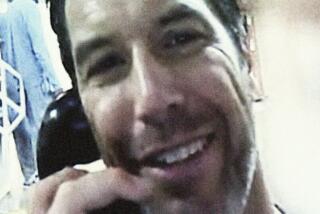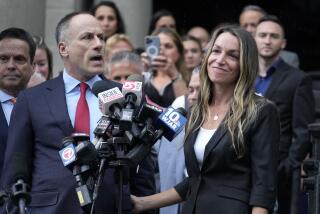Peyer’s Retrial Has Elements of a New Drama, Not Just a Replay
- Share via
The muddy creek bed beneath an abandoned highway bridge in northern San Diego bears no trace of the tragedy that unfolded there 17 months ago.
Signs that a young college student was strangled and tossed to the stream bed from a freeway bridge arching above it did not linger long. And today, the shrubbery that carpets the steep slopes rising from the site belies the violence that occurred there Dec. 27, 1986.
For the record:
12:00 a.m. May 18, 1988 For the Record Victim in Murder Case Incorrectly Identified
Los Angeles Times Wednesday May 18, 1988 San Diego County Edition Part 1 Page 2 Column 6 Metro Desk 2 inches; 51 words Type of Material: Correction
A story Monday about the retrial of former California Highway Patrol Officer Craig Peyer incorrectly identified the victim in another murder case involving a state patrolman from Barstow. The victim in that case was Robin Bishop, not Pamela Ann Rymer. Rymer was the federal judge in the trial that led to the conviction of former CHP Officer George Michael Gwaltney.
But the passage of time has not erased the community’s memory of that winter night when someone claimed the life of Cara Knott.
The slaying of the vivacious, attractive San Diego State University student, and the shock waves caused by the arrest of a veteran California Highway Patrol officer, have left a lasting imprint on many San Diegans.
Lawyers Offer No Details on Strategy
In February, the trial of former patrolman Craig Peyer ended when a Superior Court jury deadlocked 7 to 5 for conviction. But prosecutors have not given up.
Today they will launch a second attempt to convince 12 jurors that Peyer pulled Knott over on the darkened Mercy Road off-ramp of Interstate 15 while on duty and strangled her after a struggle.
Peyer’s defense attorney will again attempt to prove that authorities have the wrong man.
Neither lawyer in the widely publicized case would reveal his strategy for the retrial, which is expected to last two months. As Deputy Dist. Atty. Paul Pfingst put it, “It won’t be a repeat of the first trial, but you’ll have to pay your five bucks and come watch to find out what’s new.”
Despite the veil of secrecy, a few fresh ingredients are already evident.
The defense is entering round two at a disadvantage. Two rulings by Superior Court Judge Richard Huffman have chipped away at the case erected by attorney Robert Grimes in the first trial.
Perhaps the most damaging ruling is the one that bars testimony of four witnesses who claimed they saw a bedraggled hitchhiker acting strangely on the route Knott probably traveled the night she was killed.
Testimony about the hitchhiker--whom police at first viewed as a suspect but who was never found--was used by Grimes to illustrate that Peyer was not the only person with the opportunity to kill Knott. But Huffman concluded there was no evidence linking the hitchhiker to Knott and said presenting such testimony would invite useless speculation by jurors.
Fiber Expert’s Testimony Limited
The second ruling expected to hinder Grimes limits the allowable testimony of the defense’s fiber expert, who contradicted the findings of the prosecution’s fiber expert during the first trial. Huffman has threatened to take that ruling a step further; he said he will prohibit the defense expert, John Reffner of Connecticut, from testifying altogether if prosecutors prove his techniques are
not widely accepted in the scientific community.
Grimes declined to comment on the significance of the rulings beyond conceding that Huffman has limited the usefulness of Reffner’s appearance in court.
The prosecution, led in the first trial by veteran Deputy Dist. Atty. Joseph Van Orshoven, is in the hands of a new lawyer: Pfingst. A slim, red-haired man who hails from New York and has the accent to prove it, Pfingst was brought down from North County to prosecute Peyer. His teammate is Deputy Dist. Atty. Joan Stein, also new to the case.
Already, Pfingst, 36, who tried murders for five years in Brooklyn before moving west, has exhibited an aggressive style. His questioning of prospective jurors was more detailed and probing than that of Van Orshoven. And pretrial maneuvers won him the two rulings by Huffman that are injurious to the defense. Van Orshoven did not challenge the hitchhiker testimony or the fiber expert’s appearance in the first trial.
The witness lineup may well differ in the second trial. In interviews after the first proceeding, jurors criticized Dr. Lee Bockhacker, a former county pathologist who performed the autopsy on Knott, and labeled his testimony a weak link in the prosecution’s case.
Two other key witnesses also were discredited by some jurors: Robert Calderwood, a Fallbrook milkman, and Michelle Martin, a former security guard. Both were surprise witnesses; both were simply dismissed as liars by some jurors.
‘Different People Testifying’
Pfingst said “there will be different people testifying about different things,” but he would not reveal the names of any new witnesses or say whether any previous witnesses will be cast aside. He did, however, say that prosecutors would be “hardheaded not to learn anything” from the previous jurors’ comments, which both sides have studied. Calderwood said he does not expect to testify in the retrial.
Knott, a 20-year-old blonde who lived with her family in El Cajon, was last seen at 8:27 p.m. Dec. 27, 1986, at a gas station at Via Rancho Parkway and Interstate 15, where she had stopped for fuel on her way home from her boyfriend’s house in Escondido.
Her body was found the next morning beneath the 65-foot-high U.S. 395 bridge near the Mercy Road off-ramp. Her Volkswagen Beetle was parked nearby; the keys were in the ignition and the driver’s window was rolled down.
Peyer, a Poway resident and a patrolman for 13 years, was arrested 19 days later and charged with murder. He was later fired by the CHP, which issued a report flatly concluding that Peyer had killed Knott. Peyer has been free on bail for more than a year.
From the start, the case has attracted widespread media coverage and public interest, largely because it implicates a law officer. It marks only the second time a CHP officer has been charged with murder. In 1984, former patrolman George Michael Gwaltney was convicted in the slaying of an aspiring actress in Barstow. The federal verdict, which found Gwaltney guilty of depriving Pamela Ann Rymer of her civil rights, came after two Superior Court trials ended in hung juries.
Although it has been well over a year since Knott was killed, the public still appears to be abreast of the case: Each of more than 260 people screened as prospective jurors for the retrial last month was familiar with it.
Circumstantial Collage
Lacking witnesses to prove that Peyer had any contact with Knott, prosecutors in the first trial relied instead on a collage of circumstantial evidence gathered through modern forensic techniques.
Among the evidence in the district attorney’s arsenal were six microscopic fibers found on clothing worn by Knott and Peyer the night of the killing. Perhaps the most crucial of these was a gold fiber, recovered from Knott’s blood-stained sweat shirt, that was said to match the gold thread in the shoulder patches on Peyer’s CHP jacket. Experts said the fiber had an unusually pitted, or “sandblasted,” appearance, and was dyed in a distinctive way.
Two tiny blood spots found on Knott’s boot and on the sleeve of her sweat shirt also figured heavily in the case against Peyer. Prosecution experts testified that the spots matched Peyer’s Type A blood. Sophisticated tests that search for genetic markers determined that Peyer was the likely source of the blood, the experts said.
However, at least one juror who voted for acquittal said prosecutors failed to conclusively link the fiber and blood evidence to Peyer and that, consequently, jurors did not give it much weight.
Some jurors also said they were troubled by the lack of a clear motive. Pfingst said that he will attempt to address that concern but that it is “very difficult.”
“It’s like the guy who kills his whole family. Why does he do it? The next-door neighbor says, ‘He was a great guy and he just borrowed my wheelbarrow the other day.’ Sometimes you never figure out why they did it,” Pfingst said.
An All-New Production
Although tight-lipped about his strategy in the retrial, Pfingst said observers will see an all-new production when the curtain lifts and opening arguments begin today. The prosecutor, who during his career has handled four other retrials, two of them murder trials, said cases tried a second time are “always different.”
“The main advantage is that you have the benefit of hindsight along with the impressions of jurors from the first trial, and that helps,” Pfingst said. Handicaps include the passage of time, he said.
“Witnesses disappear, memories become dim, and it’s generally more difficult the farther away you get from the time of the crime,” Pfingst said.
The traditional edge that some feel the defense has in a criminal trial--that of being informed of all the prosecution’s witnesses and evidence but not being required to return the favor--is less pronounced in a retrial, Pfingst noted. “We’ve seen their strategy the first time around and have an idea of what type of witnesses they’ll be calling,” he said.
Grimes, meanwhile, said his mission is to “try to anticipate what changes the prosecution might make and then react to them.”
“We feel the case is pretty much a known quantity in terms of the extent of witnesses and physical evidence,” said Grimes, a soft-spoken, almost self-effacing attorney. “We have literally dozens of witnesses subpoenaed. . . . but just who we call will depend to some degree on what the prosecution does.”
More to Read
Sign up for Essential California
The most important California stories and recommendations in your inbox every morning.
You may occasionally receive promotional content from the Los Angeles Times.










